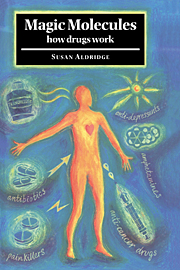Book contents
- Frontmatter
- Contents
- List of illustrations
- Acknowledgements
- Introduction
- 1 How drugs work
- 2 From penicillin to Prozac: introducing pharmaceutical drugs
- 3 Fighting infection
- 4 The hormonal revolution
- 5 Cardiovascular drugs: protecting the heart and brain
- 6 The problem of pain
- 7 The cancer challenge
- 8 Drugs for the mind
- 9 Drugs of recreation and addiction
- 10 Natural alternatives: vitamins, minerals and herbs
- 11 In the pipeline: gene-based medicine
- Bibliography
- Index
Introduction
Published online by Cambridge University Press: 05 August 2012
- Frontmatter
- Contents
- List of illustrations
- Acknowledgements
- Introduction
- 1 How drugs work
- 2 From penicillin to Prozac: introducing pharmaceutical drugs
- 3 Fighting infection
- 4 The hormonal revolution
- 5 Cardiovascular drugs: protecting the heart and brain
- 6 The problem of pain
- 7 The cancer challenge
- 8 Drugs for the mind
- 9 Drugs of recreation and addiction
- 10 Natural alternatives: vitamins, minerals and herbs
- 11 In the pipeline: gene-based medicine
- Bibliography
- Index
Summary
Drugs have an impact on all our lives. Many people rely on a daily dose of aspirin or insulin to maintain their long-term health. Others may hope for better drugs to treat challenging illnesses such as cancer or schizophrenia. Away from the realm of serious disease, casual use of painkillers or indigestion remedies relieves minor aches and pains. And most people use some form of recreational drug such as caffeine, alcohol, or nicotine to help them cope with the stresses and strains of everyday life – or just for pleasure.
New drugs are coming onto the market all the time. There are now effective treatments for stroke, AIDS, and multiple sclerosis – where none existed before. Prescribing habits change too – long-term use of tranquillisers and sleeping pills is now frowned on, and slimming drugs are, officially, off limits. The range of medicines available over the counter is continually changing too. Now you can buy the anti-ulcer drug Zantac without a prescription, but some hay-fever remedies and even paracetamol (in large quantities) have moved into the prescription only category. Walk into a health food shop and you will discover an alternative pharmacy – vitamins, minerals, phytochemicals and herbs – in a bewildering array of strengths and dosages.
But how well do we understand the drugs we are prescribed or choose to take? What informs our doctor's choices, and our own? And is there really a ‘pill for every ill’? Where do you find out about the drugs you take?
By law, companies must insert an information leaflet into every packet of a prescription drug.
- Type
- Chapter
- Information
- Magic MoleculesHow Drugs Work, pp. xi - xivPublisher: Cambridge University PressPrint publication year: 1998
- 1
- Cited by



